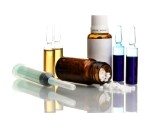Titanium Dioxide (TiO2) Photocatalysts for Water Purification
- Technology Benefits
- This groundbreaking technology has the potential to revolutionize the definition of “clean water.” Not only does it have the potential to integrate into our industrial wastewater treatment facilities, but it also can be incorporate into commercial and residential water purification products and systems. Another application allows applying this novel TiO2 composition as a harmless paint or film to public and private pools, hot tubs, or jacuzzis. By utilizing just sunlight, the water can routinely cleansed of harmful chemicals, pathogens, and odors. The University of California, Riverside is currently discussing licensing partnerships for this technology. This technology has issued as US Patent No. 7,368,183.
- Detailed Technology Description
- UCR Professor David Kisailus has developed a novel water purification method using TiO2 photocatalysts that neutralizes currently unfiltered chemicals. TiO2 is a safe, naturally occurring substance that appears in many of our household products such as paints, plastics, and toothpaste. The proprietary TiO2 composition can be applied to any substrate or surface where a light source provides the photocatalytic impetus to the TiO2 to remove these harmful chemicals, odors, parasites, and microorganisms.
- Supplementary Information
- Patent Number: US20120267321A1
Application Number: US13500716A
Inventor: Kisailus, David | Kinsinger, Nichola
Priority Date: 8 Oct 2009
Priority Number: US20120267321A1
Application Date: 16 May 2012
Publication Date: 25 Oct 2012
IPC Current: H01B000112 | C02F000172 | B82Y003000
US Class: 21074809 | 210192 | 21074814 | 25251933 | 977773 | 977903
Assignee Applicant: The Regents of the University of California
Title: METHODS OF MAKING METAL-OXIDES AND USES THEREOF FOR WATER TREATMENT AND ENERGY APPLICATIONS
Usefulness: METHODS OF MAKING METAL-OXIDES AND USES THEREOF FOR WATER TREATMENT AND ENERGY APPLICATIONS
Summary: The method is useful for producing semiconductive partial or fully porous nanoparticle-dispersant composite, which is useful in water treatment system and device for treating contaminated water (all claimed), and in photocatalysts, photovoltaics and solar hydrogen applications.
Novelty: Producing semiconductive porous nanoparticle-dispersant composite, comprises mixing e.g. a metal oxide precursor with a dispersing agent in a solvent to promote nanomaterial-dispersing agent composite formation and calcinating the mixture
- Industry
- Chemical/Material
- Sub Category
- Nano Materials
- Application No.
- 9670069
- Others
-
Tech ID/UC Case
23344/2010-119-2
Related Cases
2010-119-2
- *Abstract
-
More and more chemicals of various origins are being discharged into our local water streams, ending up at waste and water treatment facilities. These chemicals comprising of pharmaceuticals, personal care products, and other various industrial chemicals are currently not removed by typical wastewater treatment practices. Further, current regulations from the Food and Drug Administration do not require testing or removing these chemicals even as their amounts aggregate in our drinking water. Therefore, the general public is currently being exposed to these dangerous chemicals that pose significant adverse health risks.


- *IP Issue Date
- Jun 6, 2017
- *Principal Investigator
-
Name: Nichola Kinsinger
Department:
Name: David Kisailus
Department:
- Country/Region
- USA






